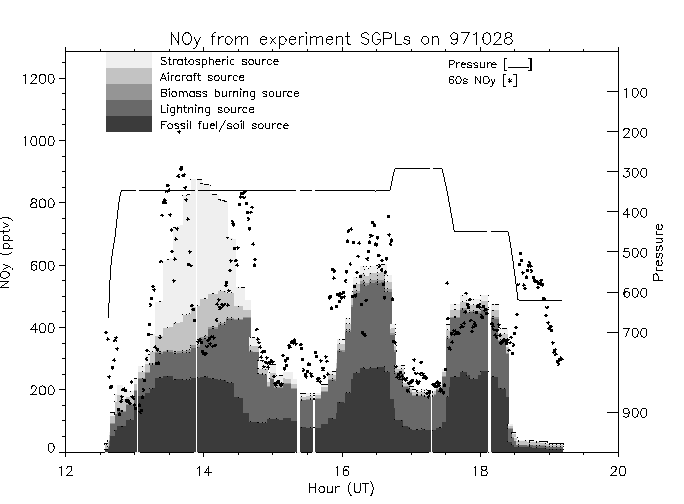
|
Long Range Transport of Pollutants

Caption
Satellite Image form AEROCE 1996
Initial results show that the air over the remote Atlantic can be as clean as over the remote Pacific, but that episodes of advection from the continents of Europe and America bring sufficient pollution to transform these areas from regions of photochemical ozone destruction (self cleaning) to regions of photochemical ozone production (smoggy). Detailed aircraft experiments in 1996 showed that both natural and man-made processes contribute to ozone events.
Aircraft emissions also emit pollutants that affect the chemical composition of the atmosphere over the North Atlantic. A major goal of the SONEX mission (measurements taken during October and November 1997) is to determine the effect of these emissions on upper tropospheric concentrations of ozone and nitrogen oxides. We are using a chemistry and transport model with enhanced horizontal resolution over the eastern United States and western Atlantic to study the relative importance of aircraft emissions on upper tropospheric mixing ratios of oxidized nitrogen (NOy)in the North Atlantic. Nitrogen oxides are an important ozone precursor that are emitted by aircraft as well as by fossil fuel combustion at the surface, soil microbial activity, lightning, biomass burning, and dissociation of nitrous oxide (N2O) in the stratosphere. A model-calculated estimate of the relative contribution of each of these terms to NOy concentrations along the 28 October 1997 SONEX flight path is shown below. Measurements are shown by asterisks while the model-calculated contributions from each source term are shown by the various color shadings.

For this particular flight, the estimated aircraft contribution to upper tropospheric NOy is small, and lightning, surface sources, and the stratosphere make large contributions. The aircraft contribution is much larger on portions of other flights (>40%), and averages ~15% along all SONEX flights in the North Atlantic Flight Corridor.
Allen, D. J., K. E. Pickering, G. L. Stenchikov, A. M. Thompson, and Y. Kondo, A three-dimensional total odd nitrogen (NOy) simulation during SONEX using a stretched-grid chemical transport model, J. Geophys. Res., submitted, 1999.
Long-range transport of atmospheric constituents is computed using the University of Maryland version of the Goddard Chemical Transport Model. This model is driven using assimilated meteorological data from the NASA Data Assimilation Office (DAO). A major activity has been the evaluation of the parameterized convective transport in the model. Recently, we have developed a modified version of the model which contains a stretched-grid feature, which allows us to focus the horizontal resolution on a region of interest, such as an area where a field measurement project was conducted.
Allen, D. J., R. B. Rood, A. M. Thompson and R. D. Hudson, Three-dimensional radon-222 calculations using assimilated meteorological data and a convective mixing algorithm, J. Geophys. Res., 101, 6871-6881, 1996.
Allen, D. J., P. Kasibhatla, A. M. Thompson, R. B. Rood, B. G. Doddridge, K. E. Pickering, R. D. Hudson, and S.-J. Lin, Transport-induced inter- annual variability of carbon monoxide determined using a chemistry and transport model, J. Geophys. Res., 101, 28,655-28,669, 1996.
Allen, D. J., K. E. Pickering, and A. Molod, An evaluation of deep convective mixing in the Goddard Chemical Transport Model using International Satellite Cloud Climatology Project cloud parameters, J. Geophys. Res., 102, 25,467-25,476, 1997.